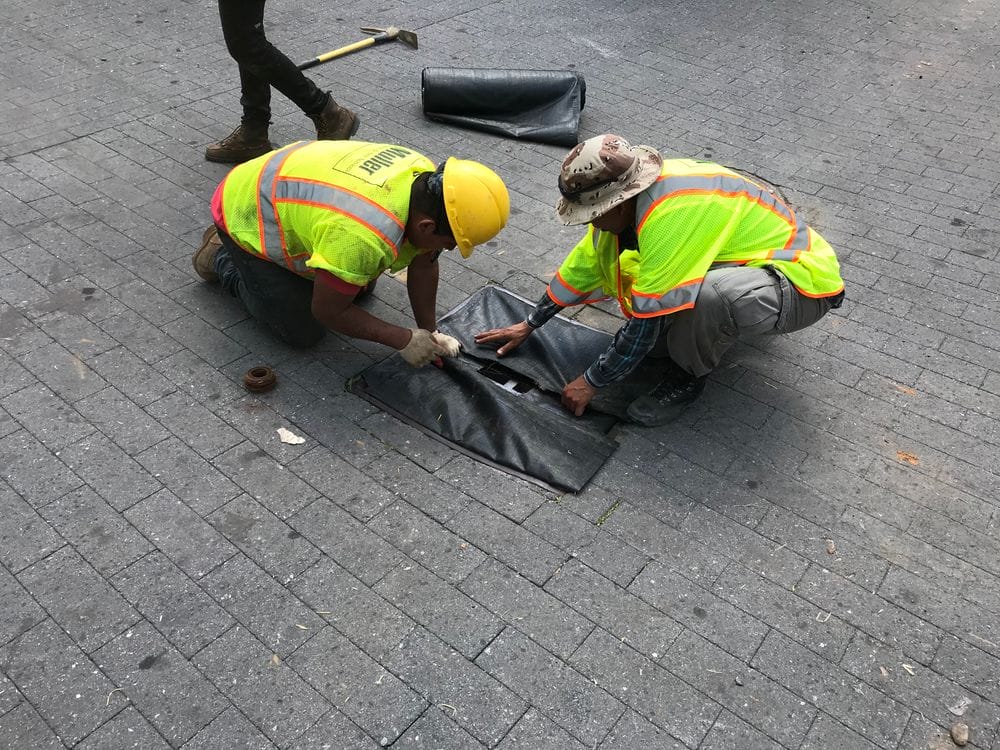Inlet protection is a term used to describe a temporary sediment control measure routinely constructed in the drainage area surrounding a storm drain, curb inlet, or drop inlet. Typically installed in areas with unstabilized land, inlet protection is designed to divert water laden with sediment and other contaminants from entering the drainage system.
Construction, utility work, landscape renovations, and other land development activities can produce debris like sediment or create non-stormwater discharges that storm-water runoff can pick up. Often, these activities are carried out in areas where those discharges end up in the gutter or street and subsequently nearby storm sewer inlets and local streams. Frequently these discharges even clog entire drainage systems.
Temporary controls can be used to protect storm sewer inlets and prevent incursions or at least minimize the volume of polluted stormwater runoff and non-storm water discharges entering a drainage system. The techniques involved include the installation of protective devices at the inlet or the implementation of temporary runoff capture devices close to the activity.
Techniques to prevent pollution
Inlet protection devices need to be constructed in order to ensure that the cleaning and removal of trapped sediment or captured contaminants can be done as easily as possible.
When an activity has been initiated that could result in an increase in the potential of storm water being polluted or the generation of non-storm water runoff, flow patterns from the site should be observed to determine whether or not flows are capable of entering gutters and streets and reaching a storm sewer inlet.
During the activity inspections should be carried out of the control devices that have been installed in order to make sure they are working in the intended manner.
Methods such as wet/dry vacuum can be utilized to remove sediment and non-storm water runoff that has been captured.
Inlet protection devices
Inlet protection devices can refer to the likes of compost and fiber logs, silt fence enclosures, rock and gravel filters, straw or hay bale barriers, concrete block/gravel/mesh wire, gutter buddies, gutter eels, silt socks, drop inlet baskets, and other structural devices. The type chosen will depend on the nature of the site.
It is a good idea to consider the use of inlet protection devices for long-term activities including construction projects, home renovations, landscaping and any other land disturbing activities involving soil, including stockpiles, being exposed.
However inlet protection devices also need to be considered for short-term activities that may feature sediment or other non-storm-water runoff laden with pollution such as utility boring.
Gravel bag check dams also need to be taken into consideration as well as direct inlet protection devices for bigger projects for installation between the gutter’s activity area and inlet. Sediment that builds up in and around inlet protection devices should be frequently cleared to make certain that the device will continue to function in the correct manner while the activity is still taking place.
Non-storm water capture devices
These devices include inlet covers and check dams that feature plastic covering to contain the runoff. Capture devices are best used with short-term activities including the washing down of paved areas and saw-cutting.
Captured non-storm water runoff needs to be removed once activities have been completed, or at least on a daily basis, and disposed of appropriately.
Other factors
Landscape waste and the likes of broken-up asphalt, concrete, gravel, and soil should not be placed in or close to storm drain inlets or in gutters that have drainage patterns to inlets. Such materials should be swept up, picked up, bagged, or otherwise disposed of in an appropriate manner.
Tarps or erosion control devices should be used to cover stockpiles, berms and unstabilized land in the event of rain or snow, even in the event that inlet protection devices have been installed.
Advantages of inlet protection
There are several advantages to the use of inlet protection. They prevent storm drainage systems from becoming clogged and the siltation of receiving waters while also reducing the amount of sediment that is able to leave the site.
This erosion and sediment control measure should be installed before any soil disturbance in the drainage area and used in conjunction with other measures, including sediment traps or small impoundments, to provide even more effective sediment removal.
Muller, Inc. operates crews trained in the installation of many different types of inlet protection throughout the Northern Virginia, Maryland, and DC Metro area. Email estimating@mullerec.com or call 703-560-4040 to find out more today.

